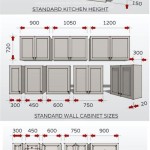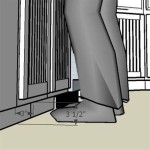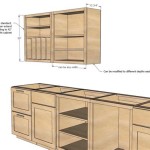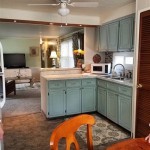Kitchen Dresser Display Ideas: Enhancing Functionality and Aesthetics
Kitchen dressers, also known as hutches or china cabinets, are versatile pieces of furniture that can significantly enhance both the functionality and aesthetics of a kitchen. Beyond simple storage, a well-curated kitchen dresser display can transform an ordinary kitchen into a visually appealing and highly organized space. These pieces offer ample opportunity to showcase favorite dishware, cookbooks, decorative items, and even collections, adding personality and character to the heart of the home. This article delves into various kitchen dresser display ideas, covering different styles, design approaches, and practical considerations for creating a display that is both beautiful and functional.
Understanding the Kitchen Dresser
Before exploring specific display ideas, it’s essential to understand the fundamental components and variations of a kitchen dresser. Typically, a kitchen dresser consists of two main parts: a base cabinet with drawers and cupboards for storage and a hutch or upper section with shelves for display. The lower section generally provides enclosed storage for items that aren't frequently used or that benefit from being hidden, such as pots, pans, and pantry staples. The upper section, with its open shelves, is the focal point for displaying decorative items and cherished dishware.
Kitchen dressers come in a variety of styles, ranging from traditional and rustic to contemporary and modern. A traditional dresser often features ornate detailing, such as carved moldings, turned legs, and glazed doors. Rustic dressers typically incorporate natural materials like reclaimed wood and distressed finishes, creating a warm and inviting atmosphere. Modern dressers, on the other hand, emphasize clean lines, minimalist design, and sleek materials like glass and metal. The style of the dresser should complement the overall aesthetic of the kitchen for a cohesive and harmonious look.
The size and configuration of the dresser also play a crucial role in determining the ideal display. A large, expansive dresser provides ample space for showcasing a variety of items, while a smaller, more compact dresser may require a more curated and selective approach. Consider the available space in the kitchen and the amount of storage and display space needed when choosing a kitchen dresser.
Key Elements of Effective Kitchen Dresser Displays
Creating a visually appealing and functional kitchen dresser display requires careful consideration of several key elements. These include balance, color coordination, layering, and intentional negative space. By mastering these principles, it is possible to create a display that is both aesthetically pleasing and practical.
Balance:
Achieving balance in a kitchen dresser display involves distributing visual weight evenly throughout the shelves. This can be accomplished through symmetrical or asymmetrical arrangements. Symmetrical balance involves mirroring the arrangement on either side of a central point, creating a formal and structured look. Asymmetrical balance, on the other hand, involves arranging items of different sizes and shapes to create a sense of equilibrium without direct mirroring. This approach tends to feel more relaxed and informal.Color Coordination:
Color plays a significant role in creating a cohesive and visually pleasing display. Selecting a limited color palette and sticking to it can help to avoid a cluttered or chaotic look. Consider incorporating colors that complement the existing kitchen décor. For example, if the kitchen features blue accents, incorporating blue dishware or decorative items into the dresser display can help to tie the space together. Neutral colors, such as white, cream, and gray, provide a versatile backdrop that allows colorful items to stand out.Layering:
Layering involves arranging items at different depths to create visual interest and dimension. Start by placing larger items at the back of the shelves and gradually working forward with smaller items. This technique allows all items to be visible and prevents the display from feeling flat. Consider using risers or small platforms to elevate certain items and create additional visual interest.Negative Space:
Negative space, or empty space, is just as important as the items on display. Leaving some areas of the shelves empty allows the eye to rest and prevents the display from feeling overcrowded. Intentionally incorporating negative space can also help to highlight specific items and draw attention to their unique features. Avoid the urge to fill every available space; a carefully curated display with strategically placed negative space is often more effective than a crowded one.Practical Display Ideas and Style Inspirations
Beyond the fundamental principles of balance, color, layering, and negative space, there are countless ways to personalize a kitchen dresser display to reflect individual style and preferences. Here are several practical display ideas and style inspirations to consider:
Dishware Collection Showcase:
One of the most common uses for a kitchen dresser is to display a cherished dishware collection. Group dishes by color, pattern, or style to create a cohesive and visually appealing arrangement. Consider using plate racks or stands to showcase particularly beautiful plates or platters. Incorporate pitchers, teapots, and serving bowls to add variety and interest to the display.Cookbook Library:
A kitchen dresser can also serve as a functional and stylish cookbook library. Arrange cookbooks by color, size, or cuisine to create a visually organized display. Use bookends to keep the books upright and prevent them from falling over. Incorporate decorative items, such as plants, bowls, or candles, to add personality and warmth to the display. Consider displaying favorite or frequently used cookbooks at eye level for easy access.Seasonal Décor:
A kitchen dresser provides an excellent opportunity to showcase seasonal décor. Decorate the dresser with pumpkins and gourds in the fall, festive ornaments and greenery during the holidays, or colorful flowers and pastel accents in the spring. Seasonal displays can add a touch of whimsy and cheer to the kitchen and create a festive atmosphere.Vintage Finds and Antiques:
Incorporate vintage finds and antiques into the kitchen dresser display to add character and charm. Display antique teacups, vintage glassware, or retro kitchen tools. These items can add a touch of nostalgia and create a unique and personalized display. Consider pairing vintage items with modern pieces to create an eclectic and interesting look.Greenery and Natural Elements:
Add life and freshness to the kitchen dresser display by incorporating greenery and natural elements. Display potted plants, succulents, or fresh herbs. Incorporate natural materials, such as wood, stone, or woven baskets, to add texture and warmth to the display. Greenery and natural elements can help to create a calming and inviting atmosphere in the kitchen.Themed Displays:
Create themed displays based on personal interests or hobbies. For example, a coffee lover might create a display featuring coffee mugs, coffee beans, and coffee-themed artwork. A baker might create a display featuring baking tools, measuring cups, and cookbooks dedicated to baking. Themed displays can add a personal touch to the kitchen and showcase individual interests.Functional Storage Solutions:
While the upper shelves of a kitchen dresser are primarily for display, the lower cabinets and drawers offer valuable storage space. Utilize this space to store items that are frequently used but not necessarily visually appealing, such as mixing bowls, baking sheets, or extra silverware. Organize the cabinets and drawers using dividers, organizers, and labels to maximize space and efficiency.Maintaining and Updating the Display
Once a kitchen dresser display is created, it's essential to maintain and update it periodically to keep it looking fresh and appealing. Dust the shelves and items regularly to prevent dust buildup. Rearrange the display periodically to create a new look and feel. Rotate items in and out of the display to keep it interesting and prevent it from becoming stale. Consider incorporating new items or seasonal décor to update the display and reflect changing tastes and trends.
Periodically assess the functionality of the display and make adjustments as needed. If certain items are not being used or appreciated, consider removing them or replacing them with more useful or visually appealing items. The goal is to create a display that is both beautiful and functional, so it's important to ensure that the items on display are serving a purpose.
Ultimately, creating a successful kitchen dresser display is about expressing personal style and creating a space that is both functional and beautiful. By following these guidelines and incorporating individual creativity, it is possible to transform an ordinary kitchen dresser into a stunning focal point that enhances the overall aesthetic of the home.

Influencer Inspired Modern Kitchen Dresser Ideas Furniture Co

Decorating 11 Ways To Stylishly Organise Your Dresser Houzz Ie

19 Ways To Style Your Dresser The Oak Furnitureland Blog

10 Styling Ideas That Make Glass Front Cabinet Displays Beautiful Lora Bloomquist Create Ponder

How To Style Glass Kitchen Cabinets Sanctuary Home Decor

Large Kitchen Dressers Welsh
:strip_icc()/101634871-9532042e1719420b859d6d4d4b732be3.jpg?strip=all)
16 Ideas For Decorating Above Kitchen Cabinets

Display Cabinets Design Ideas

10 Styling Ideas That Make Glass Front Cabinet Displays Beautiful Lora Bloomquist Create Ponder

Late Summer Early Fall Farmhouse Open Kitchen Shelves Worthing Court Diy Home Decor Made Easy
Related Posts








